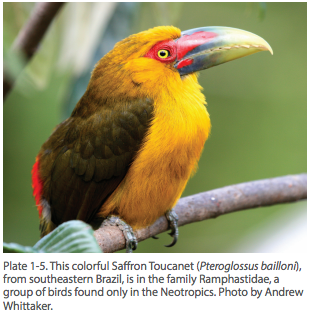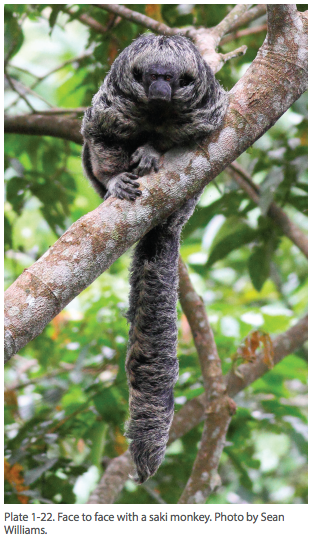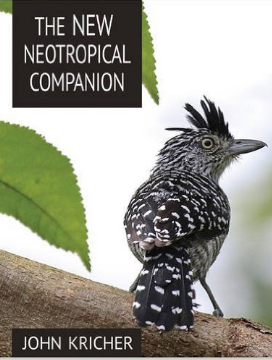The Neotropical Companion by John Kricher came out years ago, in the late 80s if I recall correctly. I've got a copy of it around somewhere.
 I loved that book because it did a great job integrating all the things in one place: animals, plants, habitats, evolution, etc. Even though I was working in the paleotropics at the time, I found it informative.
I loved that book because it did a great job integrating all the things in one place: animals, plants, habitats, evolution, etc. Even though I was working in the paleotropics at the time, I found it informative.
Then, more recently, I got a revised version of the same book. I've got it around somewhere. It is from the 1990s, I think. Great book, same idea as the first one, but with more in it, and a somewhat larger format. This dates to after my fieldwork in the rainforests, but overlapped with visits to arid regions in the tropics, though again, I'm paleo and the book is neo, but still great.
Then, I got a new copy of f Kircher's book, The New Neotropical Companion. I got this one in the future! (Not quite published yet, but I think you can actually get it now
.
 This is a serious book. To a large extent, the intended audience is folks who plan to travel in the neotropics and want a strong background in areas of evolutionary biology and conservation. But the book is very high level in terms of the material covered, the range of facts and scope of theoretical work brought to bear, and so on. It is easy to read, even engaging to read, but it is very very rich in content.
This is a serious book. To a large extent, the intended audience is folks who plan to travel in the neotropics and want a strong background in areas of evolutionary biology and conservation. But the book is very high level in terms of the material covered, the range of facts and scope of theoretical work brought to bear, and so on. It is easy to read, even engaging to read, but it is very very rich in content.
So, the book includes information on traveling, and seeing nature on your trip. But then it includes all that information on the nature itself. It is not a small book, not a field guide format (as the first version was), but it is worth lugging around if you are doing some serious visiting.
 Or, if you are simply a student of the tropics, evolutionary biology, or nature (not and, but or, on all of that) this book will be an excellent addition to your library.
Or, if you are simply a student of the tropics, evolutionary biology, or nature (not and, but or, on all of that) this book will be an excellent addition to your library.
And, it should be in school libraries, and on the shelves of biology teachers. There are many well developed examples of wildlife and evolution in here, that can be expand on with further literature review (and the book provides a handle on that) for developing in class projects.
I've put the table of contents below. As you can see, the book is well organized and covers a lot of material. Also, it is a well produced (as is typical for this publisher, Princeton) and nice looking.
The author, John Kricher, is a biology professor at Wheaton. He's also written: Galápagos: A Natural History, Tropical Ecology
, A Field Guide to California and Pacific Northwest Forests (Peterson Field Guides)
, By John Kricher - The Balance of Nature: Ecology's Enduring Myth
, and a couple of book on tape thingies such as Ecological Planet - An Introduction to Earth's Major Ecosystems: The Modern Scholar
(well, not really tape, of course).
Preface 9
Acknowledgments 11
How to Use This Book 12
1 Welcome to the Torrid Zone 15
2 Why It Is Hot, Humid, and Rainy in the Tropics 29
3 Rain Forest: The Realm of the Plants 39
4 Finding Animals in Rain Forest 58
5 Sun Plus Rain Equals Rain Forest 73
6 Essential Dirt: Soils and Cycling 81
7 If a Tree Falls . . . Rain Forest Disturbance Dynamics 95
8 Evolutionary Cornucopia 113
9 Why Are There So Many Species? 134
10 Tropical Intimacy: Mutualism and Coevolution 155
11 Evolutionary Arms Races: More Coevolution, More Complexity 181
12 Cruising the Rivers to the Sea 205
13 Scaling the Andes 235
14 Don't Miss the Savannas and Dry Forests 250
15 Neotropical Birds: The Bustling Crowd 262
16 From Monkeys to Tarantulas: Endless Eccentricities 319
17 Human Ecology in the Tropics 365
18 The Future of the Neotropics 377
Appendix Words of Caution: Be Sure to Read This 389
Further Reading 392
Index 417

Our rainforest ecology students still read this book prior to any tropical fieldtrip